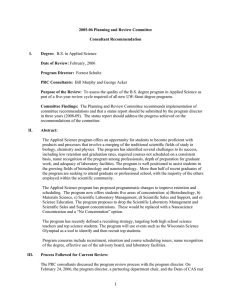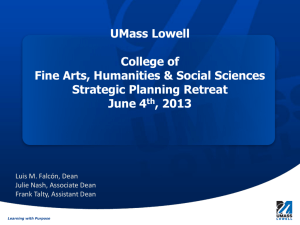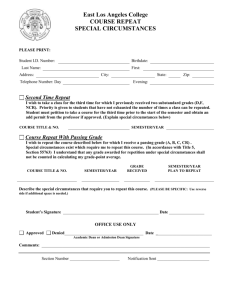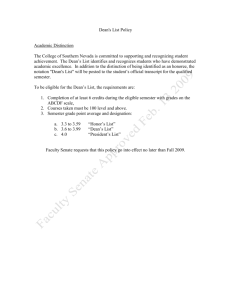DATE: TO: FROM: Response to B.S. Applied Science
advertisement
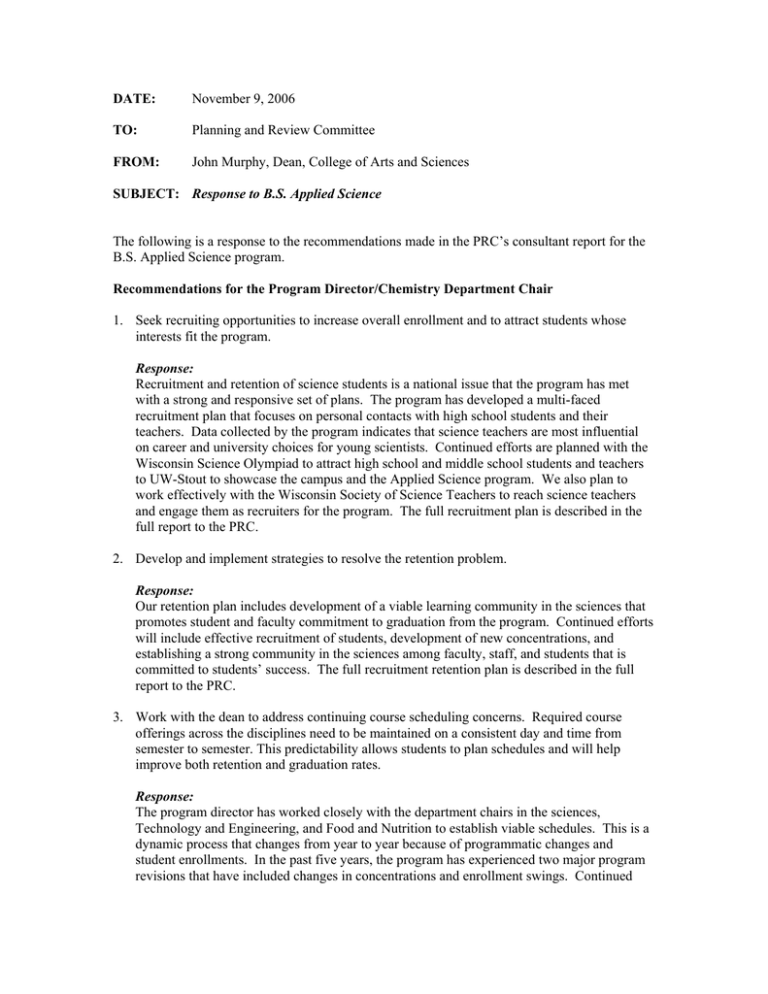
DATE: November 9, 2006 TO: Planning and Review Committee FROM: John Murphy, Dean, College of Arts and Sciences SUBJECT: Response to B.S. Applied Science The following is a response to the recommendations made in the PRC’s consultant report for the B.S. Applied Science program. Recommendations for the Program Director/Chemistry Department Chair 1. Seek recruiting opportunities to increase overall enrollment and to attract students whose interests fit the program. Response: Recruitment and retention of science students is a national issue that the program has met with a strong and responsive set of plans. The program has developed a multi-faced recruitment plan that focuses on personal contacts with high school students and their teachers. Data collected by the program indicates that science teachers are most influential on career and university choices for young scientists. Continued efforts are planned with the Wisconsin Science Olympiad to attract high school and middle school students and teachers to UW-Stout to showcase the campus and the Applied Science program. We also plan to work effectively with the Wisconsin Society of Science Teachers to reach science teachers and engage them as recruiters for the program. The full recruitment plan is described in the full report to the PRC. 2. Develop and implement strategies to resolve the retention problem. Response: Our retention plan includes development of a viable learning community in the sciences that promotes student and faculty commitment to graduation from the program. Continued efforts will include effective recruitment of students, development of new concentrations, and establishing a strong community in the sciences among faculty, staff, and students that is committed to students’ success. The full recruitment retention plan is described in the full report to the PRC. 3. Work with the dean to address continuing course scheduling concerns. Required course offerings across the disciplines need to be maintained on a consistent day and time from semester to semester. This predictability allows students to plan schedules and will help improve both retention and graduation rates. Response: The program director has worked closely with the department chairs in the sciences, Technology and Engineering, and Food and Nutrition to establish viable schedules. This is a dynamic process that changes from year to year because of programmatic changes and student enrollments. In the past five years, the program has experienced two major program revisions that have included changes in concentrations and enrollment swings. Continued close interaction with the science chairs and other chairs on campus should be continued in the future to establish a predictable yet flexible schedule that best meets student needs. 4. Improve overall communication regarding program changes and status with advisors, department chairs, participating faculty, and students. Response: The program director will work with advisors, department chairs, participating faculty and students to understand communication challenges and opportunities and implement strategies to improve people skills of students in the program. 5. Develop and implement program changes as needed to resolve the lack of people skills previously identified by the advisory committee. Response: The program director will work with the advisory committee to understand and identify the lack of people skills. Once these skills are identified, the program director will work with the program committee and the science departments to implement strategies to improve people skills of students in the program. 6. Work with deans and department chairs to resolve course content issues regarding research depth and other preparation for graduate study. Response: Many students in the program have chosen to advance their education in graduate and professional schools. As this trend grows, the program director will work with the deans and the department chairs to offer appropriate upper-level courses with content that is necessary for these students. 7. Promote the UW-Stout definition of “Applied Science” to opinion leaders in the high schools and elsewhere as part of overall recruiting and awareness efforts. Response: Through efforts with Wisconsin Science Olympiad and the Wisconsin Society of Science Teachers we plan to continue to promote the definition of “Applied Science”. 8. Work more closely with the program advisory board by meeting twice annually. Response: The program director will identify strategies to work more closely with the advisory board that will include meeting twice annually. 9. Continue to address the lab space and technical requirements through the new building committee. Response: The program director will work closely with the chairs and the Dean of CAS to ensure that the Jarvis Hall Science Wing project meets the present and future needs of the faculty, staff and students of the Applied Science program. Faculty expertise and instrumentation support and maintenance is a strong need in the Applied Science program, the program director needs to continue to work with chairs and the deans of CAS, CHD and CTEM to address this issue in a fashion that will leverage expertise across programs. Recommendations for the Dean, Colleges of Arts & Sciences 1. Work with the chairs to address continuing course scheduling concerns. Required course offerings across the disciplines need to be maintained on a consistent day and time from semester to semester. This predictability allows students to plan schedules and will help improve both retention and graduation rates. Response: The College of Arts and Sciences has begun planning on a college wide enrollment management initiative. Discussions will occur this summer between the Associate Dean and the Interim Director of Budget, Planning and Analysis to assess enrollment trends and a timeline for implementation. This enrollment management plan will apply to all departments and all programs in CAS. By its completion, we hope to have implemented an efficient, real number based plan that will align course offerings with student needs and demands. 2. Provide increased support and funding for recruiting and retention efforts for students. Response: CAS will work closely with the program and provide, within its budgetary limits, whatever support possible to enhance recruitment and retention efforts. 3. Assist in the process of improving communication about the program and its status among the departments and across the college. Response: This summer CAS is planning a meeting of all faculty and staff in Biology, Chemistry, and Physics to discuss the future of the sciences and the direction of the program. Topics to be discussed at this meeting will include: departmental structuring, program direction, course offerings/scheduling, and use of Jarvis Hall Science Wing upon completion of its remodeling. 4. Continue to address he lab space and technical requirements through the new building committee. Response: As CAS prepares for the Science Wing remodeling, the new building committee has met, and will continue to meet, with the faculty and staff of the sciences to seek their input and continue to keep them abreast of the process. As noted above, the building will serve as a lynchpin for some of the discussions at the meeting to be held later this summer. Recommendations for the Biology Department Chair 1. Work with the dean to address continuing course scheduling concerns. Required course offerings across the disciplines need to be maintained on a consistent day and time from semester to semester. This predictability allows students to plan schedules and will help improve both retention and graduation rates. Response: With the introduction of many new courses to serve the Applied Science Program, scheduling has been an issue. The chair of Biology will work with the other chairs, with assistance from the program director, to coordinate course offerings. The chairs are also working together to designate a time for seminars and student presentations. Together, these will improve retention and recruitment. A predictable course schedule is possible, however, it should be noted, that this does not mean every semester or every year. The department is developing a rotation system for course offerings, to meet the needs of all students (general education, applied science, and service courses). The department will continue to work with the dean to ensure the regularity and frequency of course offerings. 2. Work with the dean to provide increased support for recruiting and retention efforts for students, including improvement in name recognition of the program. Response: Recruitment and retention is enhanced when the community is involved in the education of the student. Although faculty is at the core of the student’s community it is important for others (including custodial, technical and office staff, deans, the provost, and the chancellor) to become part of the community. The chair will explore ways to develop these connections. 3. Assist in the process of improving communication about the program and its status within your department and across the college. Response: The Biology Department has a newsletter for faculty and staff. The newsletter includes celebrations, general announcements, a chair’s report, senate and program committee reports, and applied science news. Communication across campus regarding the program and activities is also improving. Faculty is active in the Faculty Senate, Senate of Academic Staff, the Teaching and Learning Center, and university-wide committees. Several of the 2006 CIC (Curriculum Incubation Center) grants involved science faculty working with faculty in other departments and colleges. In addition, the faculty continues to be active in their fields through research and scholarly work as well as outreach to the community. It is possible that name recognition of these efforts is going to the department and not the program. A solution might be as simple as updating business cards to read “xxx Professor of Biology in the Applied Science Program.” Emphasis on service-learning activities and industry-based problems within our curriculum will also improve name recognition of the program. 4. Continue to address the lab space and technical requirements through the new building committee. Response: The building committee for Jarvis Hall has done an excellent job of establishing lines of communication. The department chair will facilitate two-way communication with faculty. Recommendations for the Physics Department Chair 1. Work with the dean to address continuing course scheduling concerns. Required course offerings across the disciplines need to be maintained on a consistent day and time from semester to semester. This predictability allows students to plan schedules and will help improve both retention and graduation rates. Response: Most of the Physics courses, including all courses required in the Applied Science program, have been offered at the same day and time for several years. Future alterations in scheduling of existing required courses (if needed) will be done with consultation with the program director(s) involved, including the Applied Science program director. Attempts will be made to schedule additional sections of courses having increased student demand. 2. Work with the dean to provide increased support for recruiting and retention efforts for students, including improvement in name recognition of the program. Response: The Physics Department carries out recruiting and name recognition activities by being active with the Wisconsin Association of Physics Teachers and the Wisconsin Society of Science Teachers. Name recognition is fostered by presentations of scientific papers at statewide meetings of the organizations. The department contributes to organizations promoting increased participation by women in science. Recruiting efforts include both distribution of formally prepared descriptive literature for the program, and informal contact and conversation with Physics (and other science) teachers from all parts of Wisconsin. The Science Olympiad (held sometimes here on campus and sometimes elsewhere) enhances recruitment and name recognition most directly to potential students. Retention of students is viewed as especially important. The Physics Department, consistent with Stout’s reputation, makes concerted efforts to deal with students on an individual basis. This includes instructional activities but also extends to encouragement of students toward academic success. We should make this a priority when meeting with the department members’ advisee. Research participation is an additional tool to enhance students’ enthusiasm for their professional activities Perhaps this could be advanced with help from the new CAS foundation development office. 3. Assist in the process of improving communication about the program and its status within your department and across the college. Response: Communication about the program to and within the department can be enhanced by participation of department members in the program committee’s meetings and reporting back to the department. It might be helpful to have an information update issued from the program director to the faculty each semester (or as needed). To minimize the additional burden on the director’s time, the update might consist of just copies of the various documents the director produces. Across the college the department members can take opportunities to promote the program among colleagues and to students. This continues to be done by contributing scientific expertise to college-wide activities such as Honors Program colloquium and promotions to the public in general. 4. Continue to address the lab space and technical requirements through the new building committee. Response: The department has designated a committee to monitor the complex remodeling process as closely as possible. The committee stands ready to provide input to decisions on the project whenever possible. The committee includes both senior faculty with extensive experience working in scientific facilities and younger faculty who anticipate working within the new facility for many years.
